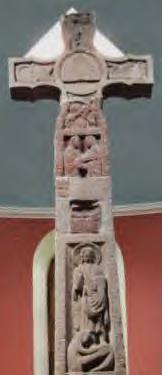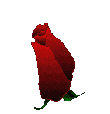Cheryl Karim


What makes the Ruthwell Cross so valuable as an artifact is its blend of elaborate ornamentation and inscriptions in both Latin letters and Anglo-Saxon runes; as well, the Cross preserves in those runes lines from a later Anglo-Saxon poem, "The Dream of the Rood."3 "The Dream of the Rood" (the oldest dream vision poem in English) powerfully describes Christ's Passion through the language of the Germanic heroic code, with the added dimension of the Rood itself as the central speaker of the poem. (Having an inanimate object speak is a hallmark of the Anglo-Saxon riddles, and in fact the passages where the Rood speaks strike some as being riddle-like.) The poem tells the story of Christ on the Cross, and with the runic text of the poem and the images on the panels, the Ruthwell Cross as a whole reinforces that story of Christ on the Cross4.
The broader (North and South) faces of the cross are carved with biblical scenes surrounded by Latin inscriptions. The narrower (East and West) faces are more decorative. These faces are carved with what has been termed 'the inhabited vine scroll'. For our purposes, these narrower faces are more important as the carvings are surrounded by runic inscriptions. However, before transcribing this it is worth giving a description of the contents of the North and South panels and their inscriptions. The South face of the cross shows scenes from the Gospels, all apparently identified by inscriptions from the Vulgate textus receptus . The Vulgate textus receptus is the first published Greek text of the New Testament. The main panel (labeled Magdalene Panel) shows Mary Magdalene bending over the feet of Christ. Presumably, she is washing them. The North face of the cross shows scenes of desert asceticism. The largest panel (labeled Judgment Panel in the figure) shows Christ in Judgment, with his right hand raised in benediction, a scroll held in his left hand. The surrounding inscription is a paraphrase of Psalm 10:13.
The Ruthwell Cross lay buried for too many years. Its successful portrayal of the beauty that can exist in religion and the hope that it offers reminds us that great poets existed long before Byron, Shakespeare and Keats. The "Dream of the Rood" was a poem that was deemed as so beautiful that it was etched into a cross which represented some of the most beautiful religious moments ever. Because of the Ruthwell Cross, the "Dream of the Rood" will live on forever-even if literature no longer gives it its due praise.

